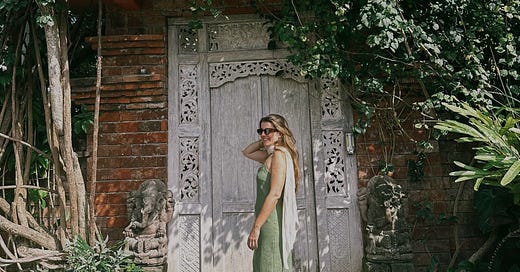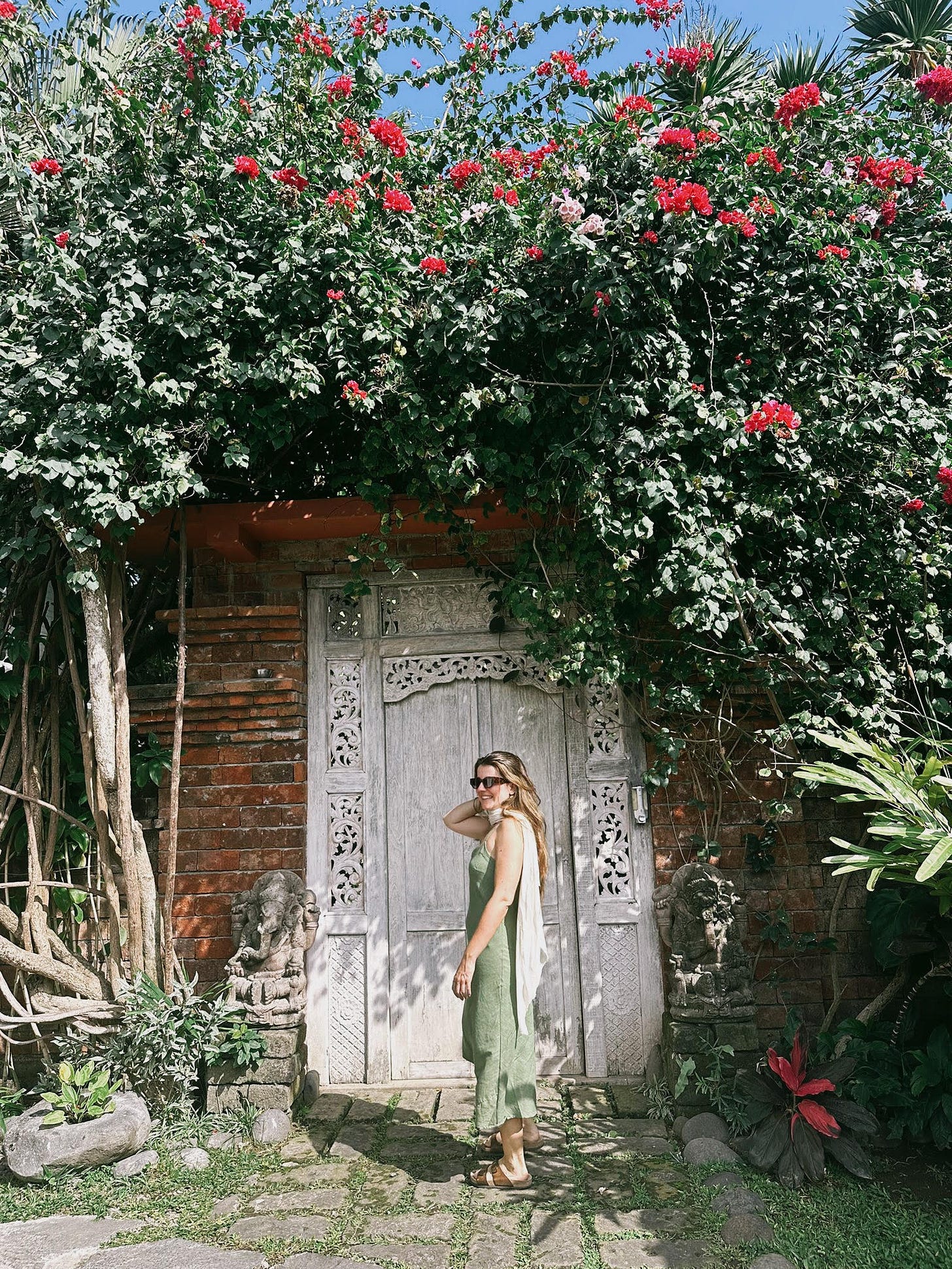The monthly newsletters are an amalgamation of musings and two poems (one by another poet and one by me, as per a practice introduced to my master’s cohort by poet Alice Oswald).
Please scroll down for upcoming online events.
Listen via audio:
Hello friends. I’m writing to you today from Bali. It’s late at night and I’m sitting with a pot of jasmine tea in a thatched roof eighteenth-century palace that’s been converted into a restaurant, lounge area and an incredible repository of antiques. There are giant statues of gods still unknown to me towering over dusty bookshelves, and the sound of running water gushing from the fountains in the gardens.
I arrived here late on Thursday night, and have been in a state of rapture ever since. There are few things I enjoy more than arriving to a new place and having the time to fully encounter it. To have the space and the courage to just let life happen.
My mother sent me a piece by Freya Stark during my first solo travel to Africa when I was seventeen, and her words have stayed with me since.
She puts it this way: ‘To awaken quite alone in a strange town is one of the pleasantest sensations in the world. You are surrounded by adventure. You have no idea of what is in store for you, but you will, if you are wise and know the art of travel, let yourself go on the stream of the unknown and accept whatever comes in the spirit in which the gods may offer it.’
This time I have a friend with me - a nice change from my usual solo travels! We’re here on a holiday for five days before setting off to the island of Sulawesi on a research trip. Located north-east of Bali, with the Philippines to the north and Papua New Guinea to the east, this Indonesian island is home to what was believed until recently to be the oldest cave art in the world.
Twelve years ago, archaeologists found what they consider to be 42,000-year-old painting near where my grandfather was from in Northern Spain. So Sulawesi now takes second place, with its paintings dated to 40,000 BC.
None the less, they are impossibly old.
It has been a dream of mine to visit this cave. But it being on the other side of the world, I never thought I would, and kind of forgot about it. Until my friend and I booked this holiday to Bali, and suddenly, I remembered! Funny how that happens.
I called her right away and coily asked how she would feel if we cut our week-long holiday short and went to do some fieldwork instead; typical me, really.
She laughed. Because only a week before, she had warned me no to turn our holiday into a research trip.
Alas.
After having a laugh, she said, “Of course, I’m always up for an adventure!”
We are friends for a reason.
But there’s more to this story I’d like to share with you today. A magics that I’m excited to tell you about!
If you’ve been reading my newsletters for some time now, you will know that I am of the belief that we can study contemporary native cultures in order to better reconstruct ancient religion. Considering Indonesia was home to such old evidence for religious experience, I wondered if there may be indigenous belief systems that find their root system in those deep cave times.
As I planned our trip, I discovered that there is a tribe in the southeast of the island who dress all in black to remember the womb of the Mother. This smelled like the old religion to me!
So I wrote to dozens of local travel agents to see if I could arrange a visit to the tribe to meet with their chief. I didn’t really expect much response. Writing as an independent researcher without the weight of an institution behind me is often met by silence and/or indifference.
But just as I was giving up – as tends to be the way - I received a response. And suddenly found myself with a willing guide.
The following morning, I was rereading the historian of religion Carl Kerenyi’s ‘Eleusis’ and was astonished to find that in his introduction, he writes that he developed his theories on the Eleusinian Mysteries based on an ethnographic study that was conducted on the Wemale people in the remote island of Ceram, which is in… Indonesia!
I was astounded that I had missed this on my first reading. Although, having just crafted a trip there, maybe it was imbedded somewhere in my subconscious?
Anyway, many scholars have drawn similarities between ancient rites and those of tribal and indigenous people, especially those whose rituals and belief systems survived from prehistoric times.
Kerenyi drew parallels between Jensen’s study and his own on Eleusis. And then Jensen went on to offer his contributions to these parallels through his lens as a historical ethnologist. What a phenomenal example of knowledge retrieval and co-creation! No doubt what scholarship should be!
My partner and I found the Wemale myth that night and read it aloud after dinner. We were entirely stunned by all the images. Such a rich and vivifying story of death and rebirth and regeneration. And the similarities with the myth of Demeter and Persephone were astounding.
Both are vegetation rites - Eleusis was so before Homer. And what can be demonstrated through them is that ancient people attributed plant regeneration to the violent death of a divine being.
If we add this to the vast examples from separate regions throughout the world, from the death of Dionysus to Osiris to Jesus, we can perhaps deduce that the common features are indicative of a common source, a prehistoric conception of the world in which regeneration formed the crux of religion.
The Wemale myth is much more violent. And depicts the brutality in confronting detail… This, perhaps, is what keeps death alive in the indigenous psyche. Not a one-sentence avoidant reference, but a deep dive that faces death head on with openness and ruthless precision.
This is important in the unraveling of our modern psyche that has been so sanitized and fumigated.
Another explanation for these striking similarities in myth and ritual between Eleusis and the Wemale is what Jung referred to as a common human foundation. He attributed his study of archetypes and a collective unconscious that connects human experience despite being separated by time and space. Mum mum actually made a beautiful documentary on this which I’ll link here: The Wisdom of the Dream
I think that instead of choosing to be of one mindset or the other, the Jungian or the historian, it is perhaps more constructive to accept them both. Because a historical transmission is only possible if we share a common human foundation in the first place.
Why is it that handprints of ochre appear in caves from 40,000 years ago in Indonesia and Spain alike? A distance of over twelve thousand kilometres…
I think we are much more alike, both to other ethnic groups and to our ancient forebears than our school books have had us think.
I look forward to sharing more about this trip with you when I return mid-August.
Until then, as usual, here is a poem. I fear to say I’ve been too busy writing my book and indulging in Balinese massages to write my own this month. But I’ve no doubt Mary Oliver will keep your heart and imagination quenched.
With all my love and great joy from this magical land, the Island of Gods.
Poetry Offering
Am I Not Among the Early Risers?
Mary Oliver
Am I not among the early risers
and the long-distance walkers?
Have I not stood, amazed, as I consider
the perfection of the morning star
above the peaks of the houses, and the crowns of the trees
blue in the first light?
Do I not see how the trees tremble, as though
sheets of water flowed over them
though it is only wind, that common thing,
free to everyone, and everything?
Have I not thought, for years, what it would be
worthy to do, and then gone off, barefoot and with a silver pail,
to gather blueberries,
thus coming, as I think, upon a right answer?
What will ambition do for me that the fox, appearing suddenly
at the top of the field,
her eyes sharp and confident as she stared into mine,
has not already done?
What countries, what visitations,
what pomp
would satisfy me as thoroughly as Blackwater Woods
on a sun-filled morning, or, equally, in the rain?
Here is an amazement–––once I was twenty years old and in
every motion of my body there was a delicious ease,
and in every motion of the green earth there was
a hint of paradise,
and now I am sixty years old, and it is the same.
Above the modest house and the palace–––the same darkness.
Above the evil man and the just, the same stars.
Above the child who will recover and the child who will
not recover, the same energies roll forward,
from one tragedy to the next and from one foolishness to the next.
I bow down.
Have I not loved as though the beloved could vanish at any moment,
or become preoccupied, or whisper a name other than mine
in the stretched curvatures of lust, or over the dinner table?
Have I ever taken good fortune for granted?
Have I not, every spring, befriended the swarm that pours forth?
Have I not summoned the honey-man to come, to hurry,
to bring with him the white and comfortable hive?
And while I waited, have I not leaned close, to see everything?
Have I not been stung as I watched their milling and gleaming,
and stung hard?
Have I not been ready always at the iron door,
not knowing to what country it opens–––to death or to more life?
Have I ever said that the day was too hot or too cold
or the night too long and as black as oil anyway,
or the morning, washed blue and emptied entirely
of the second-rate, less than happiness
as I stepped down from the porch and set out along
the green paths of the world?Upcoming Online Events
Firstly, a reminder that the next cohort of the Bee Priestesses program begins in September. Here are the details of the program: The Bee Priestesses
August 4th | New Moon Embodiment
August 25th | Dismemberment Ceremony





Wow fascinating - this is my kind of travel! Thanks for sharing!
What a lovely post Gabriela, I love the sound of this journey 🌱